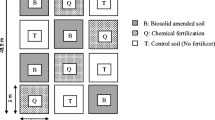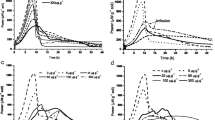Abstract
Nickel pollution may affect microbial communitydevelopment and its activity in soil and, therefore, itsfertility, while organic amendment may affect Ni mobilityand bioavailability. The aim of this research was toascertain the extent to which the addition of sewage sludgeto soil may affect Ni toxicity and to establish theecological dose of this heavy metal. Unamended and amendedsoils with sewage sludge were spiked with differentconcentrations of Ni (0–8000 mg kg-1) and then incubatedfor 3 hours, 12 days and 40 days. Soil dehydrogenaseactivity, ATP content, microbial respiration and microbialbiomass C were measured in the samples containing differentNi concentrations. A mathematical model which describe theinhibition of these soil parameters were used to calculatethe ecological dose of Ni: ED50. Soil microbialbiomass C measurements of all treatments better fitted themodel (r2 = 0.95–0.69 with p < 0.05) than the otherparameters studied; but the ED50 values predicted by the modelhad a high coefficient of variation. For both ATP contentand microbial biomass C, the ED50 values calculatedfor the amended soil were higher than for the unamendedsoil and so that the effect of Ni toxicity on theseparameters of microbial activity may be considered lower inthe former. In this study, an increase in ED50 valueswith the time elapsed was also observed.
Similar content being viewed by others
References
Adriano, D. C.: 1986, 'Nickel', in Trace Elements in the Terrestrial Environment, Springer-Verlag, New York, pp. 106–149.
Alloway, B. J.: 1995, 'Chromium and Nickel', in B. J. Alloway (ed.), Heavy Metals in Soils, Blackie Academic and Professional, Glasgow, UK, pp 153–178.
Babich, H., Bewley, R. J. F. and Stotzky, G.: 1983, 'Application of the 'Ecological Dose' concept to the impact of heavy metals on some microbe-mediated ecological processes in soil', Arch. Environ. Con. Tox. 12, 421–426.
C.E.C.: 1986, 'Council directive on the protection of the environment, and in particular of the soil, when sewage sludge is used in agriculture', Official Journal of European Communities L181, 6–12.
Ciardi, C. and Nannipieri, P.: 1990, 'A comparison of methods for measuring ATP in soil', Soil Biol. Biochem. 22, 725–727.
Dixon, M. and Webb, E. C.: 1979, Enzymes, 3rd ed. Longman, London.
Doelman, P. and Haanstra, L.: 1984, 'Short-term and long-term effects of cadmium, chromium, copper, nickel, lead and zinc on soil microbial respiration in relation to abiotic soil factors', Plant Soil. 79, 317–327.
Doelman, P. and Haanstra, L.: 1989, 'Short-and long-term effects of heavy metals on phosphatase activity in soils: An ecological dose-response model approach', Biol. Fert. Soils. 8, 235–241.
Doelman, P. and Haanstra, L.: 1986, 'Short-and long-term effects of heavy metals on urease activity in soils', Biol. Fert. Soils. 2,213–218.
Giller, K. E., Witter, E. and McGrath, S. P.: 1998, 'Toxicity of heavy metals to microorganisms and microbial processes in agricultural soils: A review', Soil Biol. Biochem. 30, 1389–1414.
Haanstra, L. and Doelman, P.: 1991, 'An ecological dose-response model approach to short-and long-term effects of heavy metals on arylsulphatase activity in soil', Biol. Fert. Soils, 11, 18–23.
Haanstra, L., Doelman, P. and Oude Voshaar, J. H.: 1985, 'The use of sigmoidal dose response curves in soil ecotoxicological research', Plant Soil. 84, 293–297.
Kandeler, E., Tscherko, D., Bruce, K. D., Stemmer, M., Hobbs, P. J., Bardgett, R. D. and Amelung, W.: 2000, 'Structure and function of the soil microbial community in microhabitats of a heavy metal polluted soil',Biol. Fert. Soil. 32, 390–400.
Killham, K.: 1985, 'A physiological determination of the impact of environmental stress on the activity of microbial biomass', Environ. Pollut. Series Acta 38, 283–294
McBride, M. B.: 1989, 'Reactions Controlling Heavy Metal Solubility in Soils', in B. A. Stewart (ed.), Advances in Soil Science, Vol. 10. Springer-Verlag, New York, pp 1–56.
Moreno, J. L., Hernández, T. and García, C.: 1999, 'Effect of a cadmium-contaminated sewage sludge compost on dynamics of organic matter and microbial activity in an arid soil, Biol. Fertil. Soils 28, 230–237.
Naseby, D. C. and Linch, J. M.: 1989, 'Establishment and impact of Pseudomonas fluorescen genetically modified for lactose utilization and kanamicin resistance in the rhizosphere of pea', J. Appl. Microbiol. 84, 169–175.
Seaker, E. M. and Sopper, W. E.: 1988, 'Municipal sludge for minespoil reclamation: I. Effects on microbial populations and activity' J. Environ. Qual. 17, 591–597.
Sopper, W. E. and Seaker, E. M.: 1987, 'Sludges brings life to microbial communities', Biocycle 28, 40–48.
Speir, T. W., Kettles, H. A., Parshotam, A., Searle, P. L. and Vlaar, L. N. C.: 1999, 'Simple kinetic approach to determine the toxicity of As[V] to soil biological properties', Soil Biol. Biochem. 31, 705–713.
Speir, T. W., Kettles, H. A., Parshotam, A., Searle, P. L. and Vlaar, L. N. C.: 1995, 'A simple kinetic approach to derive the ecological dose value, ED50, for the assessment of Cr (VI) toxicity to soil biological properties', Soil Biol. Biochem. 27, 801–810.
Vance, E. D., Brookes, P. C. and Jenkinson, D. S.: 1987, 'An extraction method for measuring soil microbial biomass C', Soil Biol. Biochem. 19, 703–707.
Von Mersi, W. and Schinner, F.: 1991, 'An improved and accurate method for determining the dehydrogenase activity of soils with iodonitrotetrazolium chloride', Biol. Fert. Soils 11, 216–220.
Webster, J., Hampton, G. and Leach, F.: 1984, 'ATP in soil: a new extractant and extraction procedure', Soil Biol. Biochem. 16, 335–342.
Welp, G.: 1999, 'Inhibitory effects of the total and water-soluble concentrations of nine different metals on the dehydrogenase activity of a loess soil', Biol. Fert. Soils 30, 132–139.
Welp, G and Brümer, G. W.: 1997, 'Toxicity of increased amounts of chemicals and the doseresponse curves for heterogeneous microbial populations in soil', Ecotoxicol. Environ. Saf. 37, 37–44.
Witter, E., Giller, K. E. and McGrath, S. P.: 1994, 'Long-term effects of metal contamination on soil microorganisms', Soil Biol. Biochem. 26, 421–422.
Author information
Authors and Affiliations
Corresponding author
Rights and permissions
About this article
Cite this article
Moreno, J.L., Pérez, A., Aliaga, A. et al. The Ecological Dose of Nickel in a Semiarid Soil Amended with Sewage Sludge Related to the Unamended Soil. Water, Air, & Soil Pollution 143, 289–300 (2003). https://doi.org/10.1023/A:1022853812926
Issue Date:
DOI: https://doi.org/10.1023/A:1022853812926




